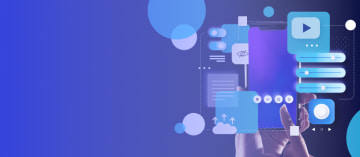Guides & best practices
View all articlesBest practices for optimizing your lead generation landing page
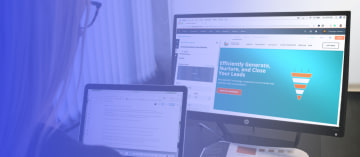
You’ve gotten them to the door, now welcome them in! 🚪👋
Converting visitors into full-fledged clients or customers isn’t an accident, it’s built on best practices. We share how to generate more leads, win higher conversion rates, and make a stellar landing page.
Come on in. 🍵🫖
Lead generation landing page best practices: lessons + confessions from the pros
"A user interface is like a joke. If you have to explain it, it’s not that good."
– Martin LeBlanc, Designer and Entrepreneur
Though the goal of your landing page may not be laughter, high-converting landing pages still follow essential design best practices that resonate with Martin’s quote. From navigation to copy, if you need to over-explain anything, your landing page isn’t doing its job.
With that on the table, let’s serve twelve piping-hot landing page best practices derived from success (or horror!) stories.
1. Use clear, concise, and consistent language (the three Cs)
Clear, concise, and consistent landing page copy turns visitors into paying customers. The three Cs behind great copywriting for lead generation landing pages are:
Clear: Draw attention to where you focus. Minimize complicated jargon, and demonstrate a clear value proposition.
Concise: Concise and persuasive copy go hand-in-hand. Utilize bullet points, simple sentences, and only include what’s important.
Consistent: Reassure visitors they’re in the right place by creating a message match between what you offer and what you say. Successful landing pages use consistent language when talking about what they offer: and keep in mind the language the visitor has seen before they reached your landing page.
A great copywriting tool to help you navigate the three C’s is the Hemingway Editor. It allows you to clean and condense your copy so it’s easier to digest. It’s up to you to ensure what you’re saying remains consistent.
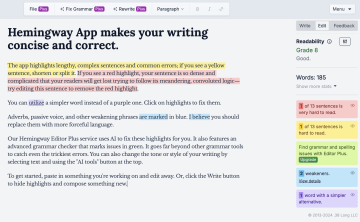
2. Know your audience
Lead capture landing pages speak to their target audience, but you’ll need to know who you’re speaking to if you want to do this successfully. To craft an effective lead gen landing page, ask yourself the following questions:
What pain points do my customers have?
How does my product or service help them solve that pain?
How do my customers talk about their problems + potential solutions?
These three questions are the core of your lead gen landing page copy. Answering them will help you push pain points and focus on benefits in a language that feels familiar to your visitor. Answers to these questions will enable you to communicate more empathetically and have landing page visitors feel understood.
⚠️ Note: Knowing your audience is not segmentation. Landing page segmentation tactics are another layer to your lead generation efforts that we’ll save for another blog!
Layla Eco - the AI property management tool does this exceptionally well. The team at Layla knows their target audience, real estate managers, have varying pain points when managing their properties, so they’ve designed a landing page that addresses them all.
“We wanted our lead generation landing page to speak to multiple pain points, but without taking up too much scroll time. With our landing page, we manage to address our wider audience within one line of text.”
- Guy Nachum, CEO.
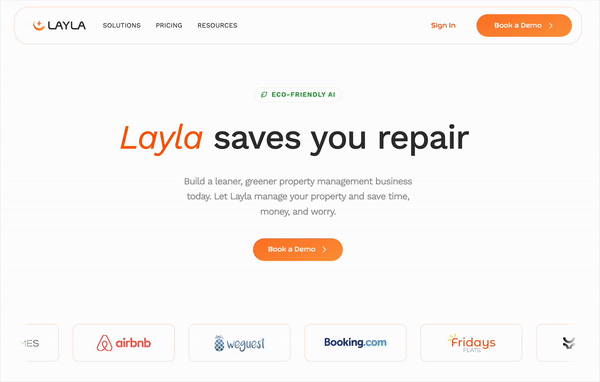
3. Use direct CTAs (calls-to-action)
CTAs (calls to action) are potentially the most important part of any landing page. CTAs are your proposal in a sentence (or less!). They’re the final nudge someone needs to sign up or buy.
So, how do you turn interest into action? Here’s how we do CTAs at Heyflow:
Use the imperative. Verbs with directions, like “download,” “try now,” and “sign up” are great for inspiring action.
Utilize a button. Make it easy for the user to complete your desired action by creating a stand-out button.
Follow the three Cs. Align your CTA with the rest of your content, keep it consistent, clear, and concise.
Pick a color: We’ve found an increase in CTA clicks by sticking to a consistent color palette for our CTAs. We have a bold purple that we save for the most important things on the page.
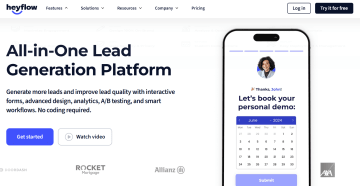
4. Keep the action above the fold
Though this paperback saying has transformed from its newspaper origins, the message remains of equal value. What once was the fold on the newspaper is now the scroll of a landing page. Yet, the recipe remains – put the cherry on top.
What’s known as information hierarchy draws users naturally through your landing page content giving them what they need first, and what they didn’t know they needed to come. Holafly does a great job of putting the important information and opportunity to convert above the fold.
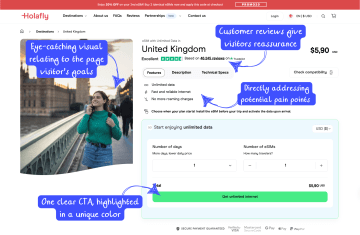
Above-the-fold content on a London eSIM landing page with Holafly.
They then proceed to deliver the extra reading for those who need a little more reassurance, below the fold.
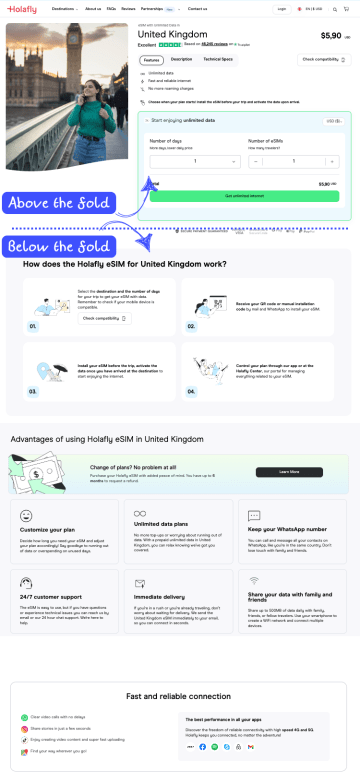
5. Offer something relevant
Everything's better with an incentive. Consider offering a lead magnet like a free download, subscription trial, or newsletter with your lead capture form.
Through the good ole foot-in-the-door method, your visitor will have more contact and content to get to know you, appreciate your value, and convert further down the line if they’re not ready to do so right now.
Real estate industries are great for taking this approach. For example, Idealista, a popular home buying and selling website in southern Europe offers free property evaluations in exchange for a page visitor’s email address. In helping people get a foot in the door, they get a foot in the inbox. 💌
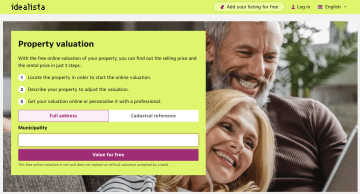
6. Only ask for essential information
Lead generation is just the beginning of a long, healthy client relationship. To begin with, collect only the information you need.
Initial lead capture information to gather:
Email
First and last name
That’s it! You can get to know each other more later on. Use form fields that are easy to find, fill out, and submit for successful lead gen efforts. A good option to embed into your forms is for autocompletes. For example, “Sign-up with Google”. This will give the visitors fewer clicks to submit - securing the information you need faster.
7. Ease navigation and remove distractions
When you minimize distraction, you optimize conversion. While it’s cool to be catchy, it’s effective to be clear, and you’ll need to find the middle ground of drawing a visitor in as well as converting them.
Armin Tanovic, Senior Writer at dslx, specializes in UX writing. These are his three best practices for landing page UX/UI design:
Use directional cues: like arrows or animation to guide users to a desired action
Optimize CTA buttons: with placement, size, and colors that stand out
Minimize:
External linking: Links whisk visitors down alternative information paths and away from your CTA.
Excessive photos: These clutter the UI and distract visitors from your message. Once you’ve lost their attention, it can be difficult to gain it back.
Upselling or cross-selling information: Adding multiple offers and suggestions dilutes focus and can even overwhelm your visitors. Settle on one desired action and ensure all your copy points toward it.
Armin goes on to explain that “exceptional landing page design is characterized by its orderliness and complete lack of clutter. Negative space can also make your copy more readable, accentuate important sections, and enhance the overall visual appeal. Each design choice should pass a two-question litmus test:
Is this choice reducing the cognitive load for my visitors?
Does this choice bring visitors closer to clicking my CTA? Or, does it lead them away?
8. A/B test your landing page elements
A good landing page never sits still. A/B testing allows you to compare two versions or elements of the same page – and in an ideal world, there’s always a new version worth testing.
A/B testing pits one version against another to see which gets the most clicks, engagement, or results in higher conversion rates. A few landing page elements to consider A/B testing:
Ad copy
Headlines
CTA button copy
CTA button placement
Testimonial placements
Hero images
If using Heyflow to run your A/B tests you’ll be able to discover optimal landing page structure, layout, and content directly within the tool – meaning no third-party app to help you optimize.
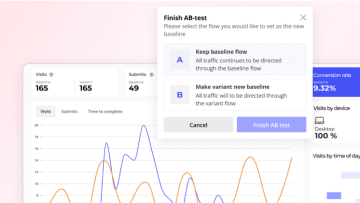
🤫 Psst. It doesn’t stop there for Heyflow users. You’ll also be able to learn from drop-off analytics, build UTM parameters, and access native integrations with Google Analytics and Matomo.
Learn more on how you can analyze and optimize your lead generation with Heyflow.
9. Optimize for mobile responsiveness
Grab leads wherever they may be by creating landing pages optimized for mobile devices: mobile phones, tablets, and everything in between.
If your ICP is extra curious, or what you’re selling is considered a high-ticket item or service, they’ll likely do their homework and visit your landing page from multiple devices. Note: this is also considered a generational move. It’s a running joke that Millennials and above won’t make a big purchase via their mobile device, but there’s truth in there too!
Optimizing your landing page for mobile responsiveness makes your user experience seamless, builds trust, and sees an uptick in conversions. And, if you’re using a tool like Heyflow, your landing pages will automatically adjust for every screen size without you needing to do a thing.

10. Use social proof for credibility
It’s an informed market out there. Even grandmothers google. So how do you stand out as tried and true? Social proof.
Testimonials allow potential leads to see that other real people are users, satisfied customers, and were once peers with similar pain points. Consider highlighting reviews, featuring influencers, or including videos of what you offer in action on your lead generation page.
Cledara, a finance tool to help businesses manage and keep track of their SaaS spend, takes a bold approach to this landing page best practice and it works wonders. The team at Cledara focus on only social proof on their sign-up page to help nudge users into their product. Take a look:
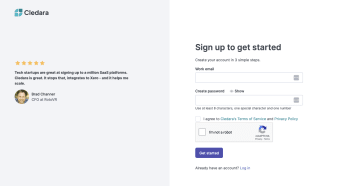
11. Maximize page speed
Even if you’re selling meditation, if your landing page doesn’t load properly within the first three seconds, you can lose the lead. Google shares as page load time goes from one to three seconds, the probability of bounce increases a whopping 32%. It’s not something your lead generation efforts can afford to skip out on.
How can you combat the dreaded load wheel?
Skip extra redirects.
Bundle up files where you can.
Compress images so they look great, but don’t take forever to load.
Turn on browser caching so people can load saved parts of your site the next time they visit.
Move or delay JavaScript that isn’t urgent so the important stuff loads first.
Limit the number of add-ons or plugins that may slow things down.
Clean up CSS and JavaScript files by removing anything unnecessary.
Go with a solid landing page provider that prioritizes load speed– ahem. 🙄
In short: Though you want to build landing pages that are dynamic, interactive, and good-looking, it’s important not to overwhelm your page to the point that it will compromise performance.
Wrapping up lead generation landing page best practices
There you have it, 11 lead generation landing page best practices, ready to help you turn needs into leads. If you’ve made it here, and are still wondering where to start. Try starting with Heyflow.
Heyflow offers templates for high-converting lead generation landing pages with the following features:
Minimalistic designs to ease user experience
Visual storytelling for higher engagement
Interactive form fields to qualify leads
Built-in analytic tools to adapt to market needs
Unique approaches to building trust and credibility through secure forms
Customizability to create content for your company
With industry-specific templates, sleek and interactive designs, and seamless integration with essential industry tools, Heyflow makes lead capture landing pages easy. Try Heyflow for free today.
_____________________________
Optimize your lead generation landing pages with Heyflow!
Heyflow offers built-in A/B testing, seamless integrations, and advanced analytics to help you design, track, and optimize your landing pages for better conversions



